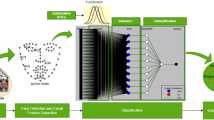Abstract
Automatic emotion recognition is a critical part of human-machine interactions. Reflection of emotions and to develop its understanding is crucial to provide dealings across human beings and machine frameworks. This work determines an automatic system that distinguishes different emotions connoted on the face. The framework is deliberated to apply the hybridization of feature extraction and optimization using PCA and PSO, respectively, to accomplish a high precision rate. PCA is used to get high-quality feature vectors for each category of emotion. Swarm intelligence, optimization is applied to get an optimized feature vector which is essential for classifying the features in the testing phase. For exploratory work, the authors have considered the Japanese Female Facial Expression (JAFFE) dataset. A maximum classification rate of 94.97% is achieved with the proposed technique. The proposed framework execution is assessed in terms of the false rejection rate, false acceptance rate, and accuracy.








Similar content being viewed by others
References
Agrawal D, Dubey SR, Jalal AS (2014) Emotion recognition from facial expressions based on multi-level classification. Int J Comput Vis Robot 4(4):365–389
Bastanfard A, Bastanfard O, Takahashi H, Nakajima M (2004) Toward anthropometrics simulation of face rejuvenation and skin cosmetic. Comput Anim Virtual Worlds 15(3–4):347–352
Bastanfard A, Takahashi H, Nakajima M (2004) Toward E-appearance of human face and hair by age, expression and rejuvenation. In: 2004 International conference on Cyberworlds, pp 306–311. https://doi.org/10.1109/CW.2004.65
Belhumeur PN, Hespanha JP, Kriegman DJ (1997) Eigenfaces vs. Fisherfaces: recognition using class specific linear projection. IEEE Trans Pattern Anal Mach Intell 19(7):711–720
Black MJ, Yacoob Y (1997) Recognizing facial expressions in image sequences using local parameterized models of image motion. Int J Comput Vis 25(1):23–48
Chernykh V, Prikhodko P (2017) Emotion recognition from speech with recurrent neural networks arXiv preprint arXiv:170108071
Chiranjeevi P, Gopalakrishnan V, Moogi P (2015) Neutral face classification using personalized appearance models for fast and robust emotion detection. IEEE Trans Image Process 24:2701–2711
Draper BA, Baek K, Bartlett MS, Beveridge JR (2003) Recognizing faces with PCA and ICA. Comput Vis Image Underst 91(1–2):115–137
Jain N, Kumar S, Kumar A, Shamsolmoali P, Zareapoor M (2018) Hybrid deep neural networks for face emotion recognition. Pattern Recogn Lett 115:101–106
Khorrami P, Le Paine T, Brady K, Dagli C, Huang TS (2016) How deep neural networks can improve emotion recognition on video data. In: 2016 IEEE international conference on image processing (ICIP), pp 619–623. https://doi.org/10.1109/ICIP.2016.7532431
Krestinskaya O, James AP (2017) Facial emotion recognition using min-max similarity classifier. In: International Conference on Advances in Computing, Communications and Informatics (ICACCI), pp 752–758
Kumar S, Singh S, Kumar J (2018) Automatic live facial expression detection using genetic algorithm with haar wavelet features and SVM. Wirel Pers Commun 103(3):2435–2453
Lopes AT, de Aguiar E, De Souza AF, Oliveira-Santos T (2017) Facial expression recognition with convolutional neural networks: coping with few data and the training sample order. Pattern Recogn 61:610–628
Lyons MJ, Akamatsu S, Kamachi M, Gyoba J, Budynek J (1998) The Japanese female facial expression (JAFFE) database. In: Proceedings of third international conference on automatic face and gesture recognition, pp 14–16. https://doi.org/10.5281/zenodo.3451524
Moore S, Bowden R (2011) Local binary patterns for multi-view facial expression recognition. Comput Vis Image Underst 115(4):541–558
Murtaza M, Sharif M, AbdullahYasmin M, Ahmad T (2019) Facial expression detection using six facial expressions hexagon (SFEH) model. In: 2019 IEEE 9th annual computing and communication workshop and conference (CCWC), pp 0190–0195
Saeed A, Niese R, Elzobi M (2014) Frame-based facial expression recognition using geometric features. Adv Hum-Comput Interact 1–13. https://doi.org/10.1155/2014/408953
Sánchez A, Ruiz JV, Moreno AB, Montemayor AS, Hernández J, Pantrigo JJ (2011) Differential optical flow applied to automatic facial expression recognition. Neurocomputing 74(8):1272–1282
Shang YC, Yan-Feng S, Bao-Cai Y (2009) A novel hybrid approach based on sub pattern technique and extended 2DPCA for color face recognition. In: Proceedings of the 11th IEEE international symposium on multimedia, pp 630–634. https://doi.org/10.1109/ISM.2009.24
Torres L, Reutter J, Lorente L (1999) The importance of the color information in face recognition in proceedings of International Conference on image Processing, 3:627–631. https://doi.org/10.1109/ICIP.1999.817191
Virrey RA, Liyanage CDS, Petra MIBPH, Abas PE (2019) Visual data of facial expressions for automatic pain detection. J Vis Commun Image Represent 61:209–217
Yang J, Zhang D, Frangi AF, Yang JY (2004) Two-dimensional PCA: a new approach to appearance-based face representation and recognition. IEEE Trans Pattern Anal Mach Intell 26(1):131–137
Zhang T, Zheng W, Cui Z, Zong Y, Li Y (2018) Spatial–temporal recurrent neural network for emotion recognition. IEEE Trans Cybern 49(3):839–847
Author information
Authors and Affiliations
Corresponding author
Additional information
Publisher’s note
Springer Nature remains neutral with regard to jurisdictional claims in published maps and institutional affiliations.
Significance of the Work
A framework proposed in this article will be helpful for the automatic facial emotion recognition system based on facial expression. A hybridization of feature extraction and optimization using PCA and PSO has been employed in this work to achieve acceptable recognition results.
Rights and permissions
About this article
Cite this article
Arora, M., Kumar, M. AutoFER: PCA and PSO based automatic facial emotion recognition. Multimed Tools Appl 80, 3039–3049 (2021). https://doi.org/10.1007/s11042-020-09726-4
Received:
Revised:
Accepted:
Published:
Issue Date:
DOI: https://doi.org/10.1007/s11042-020-09726-4




